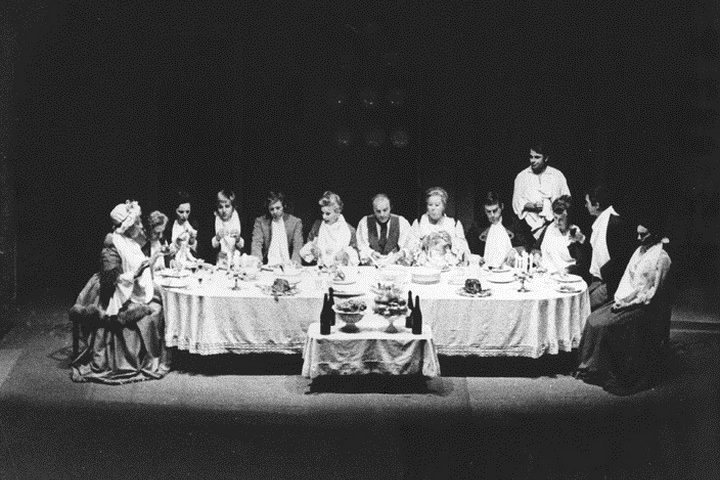Debutto: Venezia, Teatro La Fenice, XXVII Festival Internazionale del Teatro di Prosa, 27 settembre 1968
| Regia | Luigi Squarzina |
| Scene e costumi | Gianfranco Padovani |
| Musiche | Fernando Cazzato Mainardi |
| Produzione | Teatro Stabile di Genova |
Personaggi e interpreti
| Sior Zamaria Testor, cioè fabbricante di stoffe | Camillo Milli |
| Siora Domenica, sua figlia | Lucilla Morlacchi |
| Sior Anzoletto, disegnatore di stoffe | Giancarlo Zanetti |
| Sior Bastian, mercante di seta | Eros Pagni |
| Siora Marta, sua moglie | Esmeralda Ruspoli |
| Sior Lazzaro, fabbricante di stoffe | Toni Barpi |
| Siora Alba, sua moglie | Elsa Vazzoler |
| Sior Augusto, fabbricante di stoffe | Gianni Fenzi |
| Siora Eleneta, sua moglie | Grazia Maria Spina |
| Siora Polonia, che fila oro | Wanda Benedetti |
| Sior Momolo, manganaro | Omero Antonutti |
| Madama Gatteau, vecchia francese ricamatrice | Lina Volonghi |
| Cosmo, garzone lavoratore di Zamaria | Renzo Martini |
| Baldissera, garzone lavoratore di Zamaria | Sebastiano Tringali |
| Martin, garzone lavoratore di Zamaria | Luciano Razzini |
Come già per Euripide e Shakespeare, Squarzina rende anche Goldoni nostro contemporaneo e il pubblico degli anni Sessanta del Novecento contemporaneo del grande teatro goldoniano.
La sua lettura del Carnovale è rapportata al contesto culturale, sociale e politico della Venezia della seconda metà del Settecento e alla biografia del drammaturgo. Perciò, da un lato rappresenta la visione fortemente critica di Goldoni nei confronti della borghesia e dall’altro evidenzia il dubbio del drammaturgo sulla buona tenuta della sua riforma, ma anche la fierezza e l’orgoglio per i risultati ottenuti. Ed ecco che Goldoni diventa nostro contemporaneo perché nella lettura del regista i pezzi autobiografici sono configurati “come autobiografia collettiva di una generazione teatrale” e la riforma goldoniana diventa il progetto di rinnovamento del teatro italiano del secondo dopoguerra portato avanti dai registi della nuova generazione. La “contemporaneità” nel Carnovale è ravvisata da Squarzina anche nella partenza di Anzoletto-Goldoni per Moscovia, letta come “una fuga dei cervelli dall’Italia”. E per esprimere in tutta evidenza la grande malinconia e la forte provocazione politica il regista inserisce nello spettacolo brani dei Memoires.
La messinscena è corredata da un saggio di grande spessore dal titolo omonimo con il quale Squarzina chiarisce le motivazioni della sua lettura. Lo spettacolo è accolto con grande entusiasmo dal pubblico e dalla critica.
Si ringrazia il teatro Nazionale di Genova per la concessione dell’utilizzo del materiale fotografico.

